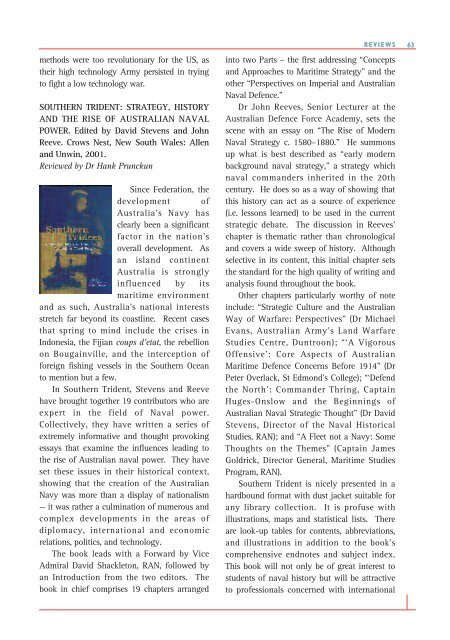ISSUE 150 : Sep/Oct - 2001 - Australian Defence Force Journal
ISSUE 150 : Sep/Oct - 2001 - Australian Defence Force Journal
ISSUE 150 : Sep/Oct - 2001 - Australian Defence Force Journal
Create successful ePaper yourself
Turn your PDF publications into a flip-book with our unique Google optimized e-Paper software.
methods were too revolutionary for the US, astheir high technology Army persisted in tryingto fight a low technology war.SOUTHERN TRIDENT: STRATEGY, HISTORYAND THE RISE OF AUSTRALIAN NAVALPOWER. Edited by David Stevens and JohnReeve. Crows Nest, New South Wales: Allenand Unwin, <strong>2001</strong>.Reviewed by Dr Hank PrunckunSince Federation, thedevelopment ofAustralia’s Navy hasclearly been a significantfactor in the nation’soverall development. Asan island continentAustralia is stronglyinfluenced by itsmaritime environmentand as such, Australia’s national interestsstretch far beyond its coastline. Recent casesthat spring to mind include the crises inIndonesia, the Fijian coups d’etat, the rebellionon Bougainville, and the interception offoreign fishing vessels in the Southern Oceanto mention but a few.In Southern Trident, Stevens and Reevehave brought together 19 contributors who areexpert in the field of Naval power.Collectively, they have written a series ofextremely informative and thought provokingessays that examine the influences leading tothe rise of <strong>Australian</strong> naval power. They haveset these issues in their historical context,showing that the creation of the <strong>Australian</strong>Navy was more than a display of nationalism— it was rather a culmination of numerous andcomplex developments in the areas ofdiplomacy, international and economicrelations, politics, and technology.The book leads with a Forward by ViceAdmiral David Shackleton, RAN, followed byan Introduction from the two editors. Thebook in chief comprises 19 chapters arrangedREVIEWSinto two Parts – the first addressing “Conceptsand Approaches to Maritime Strategy” and theother “Perspectives on Imperial and <strong>Australian</strong>Naval <strong>Defence</strong>.”Dr John Reeves, Senior Lecturer at the<strong>Australian</strong> <strong>Defence</strong> <strong>Force</strong> Academy, sets thescene with an essay on “The Rise of ModernNaval Strategy c. 1580–1880.” He summonsup what is best described as “early modernbackground naval strategy,” a strategy whichnaval commanders inherited in the 20thcentury. He does so as a way of showing thatthis history can act as a source of experience(i.e. lessons learned) to be used in the currentstrategic debate. The discussion in Reeves’chapter is thematic rather than chronologicaland covers a wide sweep of history. Althoughselective in its content, this initial chapter setsthe standard for the high quality of writing andanalysis found throughout the book.Other chapters particularly worthy of noteinclude: “Strategic Culture and the <strong>Australian</strong>Way of Warfare: Perspectives” (Dr MichaelEvans, <strong>Australian</strong> Army’s Land WarfareStudies Centre, Duntroon); “‘A VigorousOffensive’: Core Aspects of <strong>Australian</strong>Maritime <strong>Defence</strong> Concerns Before 1914” (DrPeter Overlack, St Edmond’s College); “‘Defendthe North’: Commander Thring, CaptainHuges-Onslow and the Beginnings of<strong>Australian</strong> Naval Strategic Thought” (Dr DavidStevens, Director of the Naval HistoricalStudies, RAN); and “A Fleet not a Navy: SomeThoughts on the Themes” (Captain JamesGoldrick, Director General, Maritime StudiesProgram, RAN).Southern Trident is nicely presented in ahardbound format with dust jacket suitable forany library collection. It is profuse withillustrations, maps and statistical lists. Thereare look-up tables for contents, abbreviations,and illustrations in addition to the book’scomprehensive endnotes and subject index.This book will not only be of great interest tostudents of naval history but will be attractiveto professionals concerned with international63
















